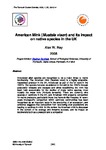American Mink (Mustela vison) and its impact on native species in the UK
| dc.contributor.author | Rey, A. | |
| dc.date.accessioned | 2019-05-10T10:46:02Z | |
| dc.date.available | 2019-05-10T10:46:02Z | |
| dc.date.issued | 2008 | |
| dc.identifier.citation |
Rey, A. (2008) 'American Mink (Mustela vison) and its impact on native species in the UK', The Plymouth Student Scientist, 1(2), pp. 302-314. | en_US |
| dc.identifier.issn | 1754-2383 | |
| dc.identifier.uri | http://hdl.handle.net/10026.1/13817 | |
| dc.description.abstract |
Introduced alien species are recognised to be a major threat to native biodiversity. The American mink (Mustela vison) is a highly adaptable, naturalised predator in the UK, introduced as part of the fur trade in the 1920‟s. The species became established in the wild in the 1950‟s through purposeful releases and escapes and since establishing the mink has been held accountable for the decline of many native species, most notably the water vole (Arvicola terrestris). There are currently nine species of carnivore in the UK, and American mink presents competition for native predators, particularly those that have similar lifestyles. In recent years interspecific competition within carnivore communities has been recognised as an important factor in the structuring of an ecosystem, and evidence suggests that competition from recovering otter populations are leading to declines in mink. In this review the American mink is discussed in the context of its ecology and invasive success, and its impact on biodiversity both as a predator and a competitor. | en_US |
| dc.language.iso | en | en_US |
| dc.publisher | University of Plymouth | |
| dc.rights | Attribution 3.0 United States | * |
| dc.rights.uri | http://creativecommons.org/licenses/by/3.0/us/ | * |
| dc.subject | alien species | en_US |
| dc.subject | American mink | en_US |
| dc.subject | Mustela vison | en_US |
| dc.subject | naturalised predator | en_US |
| dc.subject | water vole | en_US |
| dc.subject | Arvicola terrestris | en_US |
| dc.subject | carnivore communities | en_US |
| dc.subject | mink | en_US |
| dc.subject | ecology | en_US |
| dc.subject | invasive | en_US |
| dc.subject | American | en_US |
| dc.subject | UK | en_US |
| dc.title | American Mink (Mustela vison) and its impact on native species in the UK | en_US |
| dc.type | Article | |
| plymouth.issue | 2 | |
| plymouth.volume | 1 | |
| plymouth.journal | The Plymouth Student Scientist |



